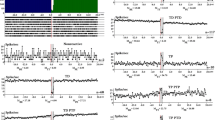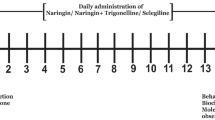Abstract
Rotenone is involved in the degeneration of dopaminergic neurons, and curcumin may prevent or effectively slow the progression of Parkinson’s disease (PD). Previous research has shown that the naturally occurring phenolic compound curcumin can reduce inflammation and oxidation, making it a potential therapeutic agent for neurodegenerative diseases. The present study involves investigation of rotenone-induced histological changes in the brain area, hippocampus using Nissl staining after 35 day of subcutaneous injection of rotenone in adult male rats. We sought to determine whether curcumin could protect against rotenone-induced dopaminergic neurotoxicity in a rat model by in vivo electrical recording from Substantia nigra pars compacta (SNc). Curcumin treatment significantly improved electrical activity of neurons in the SNc of rotenone-induced PD model rats. The pattern of histological alterations corresponds with electrophysiological manifestations.



Similar content being viewed by others
Data availability
Raw data can be provided upon request to the corresponding author.
References
Aggarwal BB, Harikumar KB (2009) Potential therapeutic effects of curcumin, the anti-inflammatory agent, against neurodegenerative, cardiovascular, pulmonary, metabolic, autoimmune and neoplastic diseases. Int J Biochem Cell Biol 41:40–59
Bancroft JD, Gamble M (2008) Theory and practice of histological techniques, 6th edn. Churchill Livingstone, London
Bayer HM, Glimcher PW (2005) Midbrain dopamine neurons encode a quantitative reward prediction error signal. Neuron 47:129–141
Breit S, Bouali-Benazzouz R, Popa RC, Gasser T, Benabid AL, Benazzouz A (2007) Effects of 6-hydroxydopamine-induced severe or partial lesion of the nigrostriatal pathway on the neuronal activity of pallido-subthalamic network in the rat. Exp Neurol 205:36–47
Caboni P, Sherer TB, Zhang N, Taylor G, Na HM, Greenamyre JT, Casida JE (2004) Rotenone, deguelin, their metabolites, and the rat model of Parkinson’s disease. Chem Res Toxicol 17:1540–1548
Calabresi P, Gubellini P, Picconi B, Centonze D, Pisani A, Bonsi P, Greengard P, Hipskind RA, Borrelli E, Bernardi G (2001) Inhibition of mitochondrial complex II induces a long-term potentiation of NMDA-mediated synaptic excitation in the striatum requiring endogenous dopamine. J Neurosci 21:5110–5120
Chan CS, Guzman JN, Ilijic E, Mercer JN, Rick C, Tkatch T, Meredith GE, Surmeier DJ (2007) Rejuvenation' protects neurons in mouse models of Parkinson's disease. Nature 447(7148):1081–1086
Cui Q, Li X, Zhu H (2016) Curcumin ameliorates dopaminergic neuronal oxidative damage via activation of the Akt/Nrf2 pathway. Mol Med Rep 13:1381–1388
Darbinyan LV, Hambardzumyan LE, Simonyan KV, Chavushyan VA, Manukyan LP, Badalyan SA, Khalaji N, Sarkisian VH (2017a) Protective effects of curcumin against rotenoneinduced rat model of Parkinson’s disease: in vivo electrophysiological and behavioral study. Metab Brain Dis 32(6):1791–1803
Darbinyan LV, Hambardzumyan LE, Simonyan KV, Chavushyan VA, Manukyan LP, Sarkisian VH (2017b) Rotenone impairs hippocampal neuronal activity in a rat model of Parkinson's disease. Pathophysiology 24(1):23–30
Darbinyan LV, Hambardzumyan LE, Simonyan KV, Chavushyan VA, Manukyan LP, Sarkisian VH (2017c) Rotenone impairs hippocampal neuronal activity in a rat model of Parkinson's disease. Pathophysiology. 24(1):23–30
Darvesh AS, Carroll RT, Bishayee A, Novotny NA, Geldenhuys WJ, Van der Schyf CJ (2012) Curcumin and neurodegenerative diseases: a perspective. Expert Opin Investig Drugs 21:1123–1140
Dauer W, Przedborski S (2003) Parkinson’s disease: mechanisms and models. Neuron 39:889–909
Ding J et al (2014) Curcumol from Rhizoma Curcumae suppresses epileptic seizure by facilitation of GABA(A) receptors. Neuropharmacology 81:244–255
Drolet RE, Cannon JR, Montero L, Greenamyre JT (2009) Chronic rotenone exposure reproduces Parkinson's disease gastrointestinal neuropathology. Neurobiol Dis 36:96–102
Dupuis JP, Feyder M, Miguelez C, Garcia L, Morin S, Choquet D, Hosy E, Bezard E, Fisone G, Bernard H (2013) Dopamine-Dependent Long-Term Depression at Subthalamo-Nigral Synapses Is Lost in Experimental Parkinsonism. J Neurosci 33(36):14331–14341
Fonck C, Nashmi R, Deshpande P, Damaj MI, Marks MJ, Riedel A, Schwarz J, Collins AC, Labarca C, Lester HA (2003) Increased sensi- tivity to agonist-induced seizures, straub tail, and hippocampal theta rhythm in knock-in mice carrying hypersensitive alpha-4 nicotinic receptors. J Neurosci 23:2582–2590
Fujiyama F, Sohn J, Nakano T, Furuta T, Nakamura KC, Matsuda W, Kaneko T (2011) Exclusive and common targets of neostriatofugal projections of rat striosome neurons: a single neuron-tracing study using a viral vector. Eur J Neurosci 33:668–677
Gao HM, Hong JS, Zhang W, Liu B (2002) Distinct role for microglia in rotenone-induced degeneration of dopaminergic neurons. J Neurosci Off J Soc Neurosci 22:782–790
Greene JG, Noorian AR, Srinivasan S (2009) Delayed gastric emptying and enteric nervous system dysfunction in the rotenone model of Parkinson's disease. Exp Neurol 218:154–161
Hartley A, Stone JM, Heron C, Cooper JM, Schapira AH (1994) Complex I inhibitors induce dose-dependent apoptosis in PC12 cells: relevance to Parkinson’s disease. J Neurochem 63:1987–1990
Hoglinger GU, Feger J, Prigent A, Michel PP, Parain K, Champy P, Ruberg M, Oertel WH, Hirsch EC (2003) Chronic systemic complex I inhibition induces a hypokinetic multisystem degeneration in rats. J Neurochem 84:491–502
Hong S, Jhou TC, Smith M, Saleem KS, Hikosaka O (2011) Negative reward signals from the lateral habenula to dopamine neurons are mediated by rostromedial tegmental nucleus in primates. J Neurosci 31:11457–11471
Kajikawa Y, Schroeder CE (2011) How local is the local field potential? Neuron 72:847–858
Kulkarni SK, Bhutani MK, Bishnoi M (2008) Antidepressant activity of curcumin: involvement of serotonin and dopamine system. Psychopharmacology 201:435–442
Leng A, Feldon J, Ferger B (2003) Rotenone increases glutamate-induced dopamine release but does not affect hydroxyl-free radical formation in rat striatum. Synapse 50:240–250
Liu YM, Fan HR, Ding J et al (2017) Curcumol allosterically modulates GABA(A) receptors in a manner distinct from benzodiazepines. Sci Rep 7:46654
Marsden KC, Beattie JB, Friedenthal J, Carroll RC (2007a) NMDA receptor activation potentiates inhibitory transmission through GABA receptor-associated protein-dependent exocytosis of GABAA receptors. J Neurosci 27(52):14326–14337
Marsden KC, Beattie JB, Friedenthal J, Carroll RC (2007b) NMDA receptor activation potentiates inhibitory transmission through GABA receptor-associated protein-dependent exocytosis of GABAA receptors. J Neurosci 27(52):14326–14337
Merwe C, van Dyk H, Engelbrecht L, van der Westhuizen FH, Kinnear C, Loos B et al (2017) Curcumin rescues a PINK1 Knock down SH- SY5Y cellular model of Parkinson’s disease from mitochondrial dysfunction and cell death. Mol Neurobiol 54(4):2752–2762
Montague PR, Hyman SE, Cohen JD (2004) Computational roles for dopamine in behavioural control. Nature 431:760–767
Moran RJ, Mallet N, Litvak V, Dolan RJ, Magill PJ, Friston KJ et al (2011) Alterations in brain connectivity underlying beta oscillations in parkinsonism. PLoS Comput Biol 7:e1002124. https://doi.org/10.1371/journal.pcbi.1002124
Morikawa H, Paladini CA (2011) Dynamic regulation of midbrain dopamine neuron activity: intrinsic, synaptic, and plasticity mechanisms. Neuroscience 198:95–111
Mythri RB, Bharath MM (2012) Curcumin: a potential neuroprotective agent in Parkinson's disease. Curr Pharm Des 18(1):91–99
Paxinos G, Watson C (2005) The rat brain in stereotaxic coordinates: compact, 6th edn. Academic Press, Cambridge
Paxinos G, Watson C (2007) The rat brain in stereotaxic coordinates, 6th edn. Academic Press, San Diego
Pienaar IS, Elson JL, Racca C, Nelson G, Turnbull DM, Morris CM et al (2013) Mitochondrial abnormality associates with type-specific neuronal loss and cell morphology changes in the pedunculopontine nucleus in Parkinson disease. Am J Pathol 183:1826–1840
Qualls Z, Brown D, Ramlochansingh C, Hurley LL, Tizabi Y (2014) Protective effects of curcumin against rotenone and salsolinol-induced toxicity: implications for Parkinson's disease. Neurotox Res 25(1):81–89
Ruby AJ, Kuttan G, Babu KD, Rajasekharan KN, Kuttan R (1995) Anti-tumour and antioxidant activity of natural curcuminoids. Cancer Lett 94:79–83
Senek M, Nyholm D (2014) Continuous drug delivery in Parkinson's disease. CNS Drugs 28(1):19–27
Song S, Nie Q, Li Z, Du G (2016) Curcumin improves neurofunctions of 6-OHDA-induced parkinsonian rats. Pathol - Res Pract 212(4):247–251
Surmeier DJ (2007) Calcium, ageing, and neuronal vulnerability in Parkinson's disease. Lancet Neurol 6(10):933–938
Surmeier DJ, Mercer JN, Chan CS (2005) Autonomous pacemakers in the basal ganglia: who needs excitatory synapses anyway? Curr Opin Neurobiol 15(3):312–318
Tepper JM, Lee CR (2007) GABAergic control of substantia nigra dopaminergic neurons. Prog Brain Res 160:189–208
Tepper JM, Martin LP, Anderson DR (1995) GABAA receptor-mediated inhibition of rat substantia nigra dopaminergic neurons by pars reticulata projection neurons. J Neurosci 15:3092–3103
Ulusoy GK, Celik T, Kayir H, Gürsoy M, Isik AT, Uzbay TI (2011) Effects of pioglitazone and retinoic acid in a rotenone model of Parkinson's disease. Brain Res Bull 85(6):380–384
Yang J, Song S, Li J, Liang T (2014) Neuroprotective effect of curcumin on hippocampal injury in 6-OHDA-induced Parkinson’s disease rat. Pathol Res Pract 210:357–362
Yu S, Zheng W, Xin N, Chi ZH, Wang NQ, Nie YX, Feng WY, Wang ZY (2010) Curcumin prevents dopaminergic neuronal death through inhibition of the c-Jun N-terminal kinase pathway. Rejuvenation Res 13(1):55–64
Author information
Authors and Affiliations
Contributions
Study Concept and Design: L.D., K.S.,V.S. Acquisition of Data: L.D., K.S.. Analysis and Interpretation of the Data: L.D., K.S., Drafting of the Manuscript: L.D., K.S., L.H., L.M., V.S., S.B.
Corresponding author
Ethics declarations
Ethics approval and consent to participate
The experimental protocol corresponded to the conditions of the European Communities Council Directive (2010/63/ UE) and it was approved by the Ethics committee of the Yerevan State Medical University after Mkhitar Heratsi (Approval code-N4 IRB APROVAL, November 15, 2018).
Competing interests
The authors declare no conflict of interest.
Additional information
Publisher’s note
Springer Nature remains neutral with regard to jurisdictional claims in published maps and institutional affiliations.
Rights and permissions
About this article
Cite this article
Darbinyan, L.V., Simonyan, K.V., Hambardzumyan, L.E. et al. Protective effect of curcumin against rotenone-induced substantia nigra pars compacta neuronal dysfunction. Metab Brain Dis 37, 1111–1118 (2022). https://doi.org/10.1007/s11011-022-00941-6
Received:
Accepted:
Published:
Issue Date:
DOI: https://doi.org/10.1007/s11011-022-00941-6




